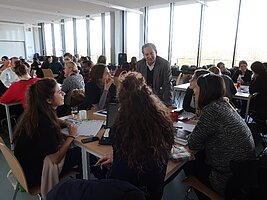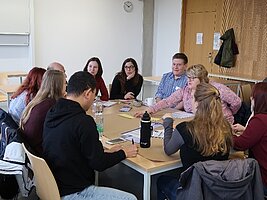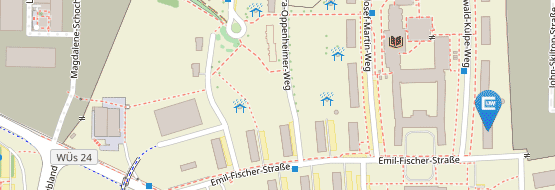Group Discussion


Aim of the strategy/method
- to develop students’ capacity for analysing and interpreting educational problems from various sociological perspectives;
- to strengthen students’ capacity for creative and critical thinking.
Setting
Classroom
Type and name of the course, curriculum, number of students
- Sociology of adult education
- Master’s level = 10
- Bachelor’s level = 20
Description of the method/ strategy
The course is delivered in the form of lectures, discussions, seminar work, and individual consultations. Students need to prepare independently and present a seminar (research paper) work. This is the basis for fostering the group discussion strategy/method.
The method can be used in the following way: After the students are familiar with the problems, the context of research, and the main ideas of the text (selected seminar topic), the teacher may start to encourage students to present those ideas to open a discussion related to adult education. Some students may need more support, whereas others can take it more independently. It may help to first discuss issues in small groups (3 students) before all move to the group (class) discussion, as students may feel more comfortable discussing issues in small groups. In the group discussion, the teacher may facilitate the dialogue by asking additional questions, by pointing students to practical examples (related to academic internships and their work in adult education organisations) and their everyday experiences, and by challenging some of their presumptions (e.g. related to structural problems causing social inequalities, migrants and migrations, employment and employability, etc.).
Students first receive concrete guidelines for preparing their seminar work. This is given and explained to them at the beginning of the course. Students may access the guidelines, as well as all other material, through an e-learning site hosted by the faculty that may be used throughout the course.
According to the guidelines given to students, they should prepare their work:
Guidelines for seminar work (structure of the text):
1. Introduction
2. Definition of the core research problem in the article
3. Summary of the article’s content
4. The main recognition (ideas) of the author (or authors)
5. Problem analysis and valuating (assessing) of the text by comparison with the basic sociological theories*
6. Conclusion with student’s critical thoughts on the selected article
--------------------------------------------------------------------------------
* Answer these questions:
1. Which questions from the sociology of education are addressed by the author(s)? Connect with the problem of the article!
2. To which theoretical sociological tradition does the author of the article belong, in your opinion (structural theory or the theory of social action - even within a particular theoretical view)? Why? How is this orientation expressed?
3. With which authors, from the sociology of (adult) education, could we combine the ideas of the author(s) in the selected text? How are their thoughts intertwined?
4. How can the key ideas/messages of the article be connected to adult education?
5. Give a brief critical assessment of the problem and content of the article.
Before presenting their work, students need to make individual appointments with the teacher (consultation process) to discuss the content of their work, select additional material for the analysis, and to choose the didactical strategies they are going to use during their presentation (e.g., how to include other students in the discussion and give them an active role while listening).
The time dimension: Students work on the preparation of their seminar work for approximately two weeks (14 days) and need to make a one-on-one appointment with the teacher one week before their presentation to discuss the topics described above. Some students see the teacher more than once.
Choice of topic: At the beginning of the course, the teacher introduces students to different articles (topics). Students are invited to choose one article (i.e. the topic for their seminar work) based on their interest.
Below are some examples of articles (topics) presented to students, who are free to choose one based on their interest:
1) Arora, B. (2015). A Gramscian analysis of the employability agenda. British Journal of Sociology of Education, 36(4), 635–648.
2) Brown, P., Power, S., Gerbrand, T., & Annabelle, A. (2014). Credentials, talent and cultural capital: A comparative study of educational elites in England and France. British Journal of Sociology of Education, 37(2), 191–211.
3) Cincinnato, S., Wever, B. D., Keer, H. V., & Valcke, M. (2016). The influence of social background on participation in adult education: Applying the cultural capital framework. Adult Education Quarterly, 66(2), 143–168.
4) Cotton, D. R. E., Nash, T., & Kneale, P. (2017). Supporting the retention of non-traditional students in higher education using a resilience framework. European Educational Research Journal, 16(1), 62–79.
6) Lopes, A. (2014). The university as power or counter-power? May 1968 and the emergence of a new learning subject. European Journal for Research on the Education and Learning of Adults, 5(1), 31–49.
7) Fejes, A. (2019). Adult education and the fostering of asylum seekers as ‘full’ citizens. International Review of Education, 65(2), 233–250.
8) Mok, K. H. (2016). Massification of higher education, graduate employment and social mobility in the Greater China region. British Journal of Sociology of Education, 37(1), 51–71.
9) Nairz-Wirth, E., Feldmann, K., & Spiegl, J. (2017). Habitus conflicts and experiences of symbolic violence as obstacles for non-traditional students. European Educational Research Journal, 16(1), 12–29.
10) Olson, M., Fejes, A., Dahlstedt, M., & Nicoll, K. (2015). Citizenship discourses: Production and curriculum. British Journal of Sociology of Education, 36(7), 1036–1053.
11) Olssen, M. (2016). Neoliberal competition in higher education today: Research, accountability and impact. British Journal of Sociology of Education, 37(1), 129–148.
13) Robertson, S. L. (2016). Piketty, capital and education: A solution to, or problem in, rising social inequalities? British Journal of Sociology of Education, 37(6), 823–835.
14) Simmons, R., & Smyth, J. (2016). Crisis of youth or youth in crisis? Education, employment and legitimation crisis. International Journal of Lifelong Education, 35(2), 136–152.
15) Tett, L. (2016). Learning, literacy and identity: ‘I don’t think I’m a failure anymore’. British Journal of Sociology of Education, 37(3), 427–444.
16) Torres, C. A. (2015). From Hamburg to Belem: The limits of technocratic thinking in adult learning education. International Journal of Lifelong Education, 34(1), 22–31.
17) Webb, S. (2015). ‘It’s who you know not what’: Migrants’ encounters with regimes of skills as misrecognition. Studies in Continuing Education, 37(3), 267–285.
18) Finnegan, F., Valadas, S., O’Neill, J., Fragoso, A., & Paulos, L. (2019). The search for security in precarious times: Non-traditional graduates perspectives on higher education and employment. International Journal of Lifelong Education, 38(2), 157–170.
First, as mentioned above, students need to make an individual appointment with the teacher to discuss their understanding of the topic and didactical approaches to the presentation and group work. The teacher can help students with understanding the topic, suggest further reading, give students some relevant examples from the national context to which the topic is connected, suggest presentation techniques (e.g. how to structure the PowerPoint presentation, how to use video material (YouTube) related to the topic in the classroom presentation, how to structure work in pairs or small groups, how to actively engage students in the presentation of the topic, etc.). Some tips about didactical strategies that can be used for fostering active learning and small group teaching, about selecting questions for discussion, and so on can be found at Leicester Learning Institute[1]). The students can be helped by directing them in different ways.
Giving practical examples can be especially helpful for students to find their argumentation and to react to actual practice in the national or local environment related to adult education (e.g., if the topic is related to migration and migrants, then practical examples may come from the adult education programmes for migrants offered in the country; if the topic is related to active citizenship, then practical examples may be related to study circles adults are engaged in). By not giving students the full answers in advance during the consultation, the teacher can try to stimulate their independent and creative thinking.
This also depends on the students’ interest and engagement in the course and the topic analysed. Some students are more autonomous and feel more comfortable, so they asl questions and lead the discussion in a quite autonomous way. Here, the teacher may just add some sub-questions or give some comments – it depends on the students’ ability to engage other colleagues in the discussion. However, some students are more open to using the discussion method and need more help in the argumentation segment. In this case, the teacher will intervene more often, providing some clarifications or giving some additional comments, also asking questions and helping students to continue with leading the discussion.
We recommend that teachers (1) initially leave the initiative to students, (2) then provide some comments, or (3) intervene more and take the initiative if the discussion is not unfolding.
Materials required
The seminar work, prepared by students, is based on an analysis of the relevant international article that covers some sociological perspective in adult education. To apply the group discussion method, published articles can be used as materials. Students can search for article resources in some of the following suggested journals: British Journal of Sociology of Education, International Studies of Sociology of Education, Adult Education Quarterly, European Journal for Research on the Education and Learning of Adults, International Review of Education, International Journal of Lifelong Education, Studies in Continuing Education, Studies in the Education of Adults, European Educational Research Journal, and the like.
Students are free to choose the article (topic) to be discussed according to their interest (see box).
Suitable articles must meet the following criteria:
- they address the goals described in the course curriculum;
- they are published in English in recognised international journals covering topics in the sociology of education;
- they are updated each year so students work on more recently published and updated articles;
- they are based on relevant theories (defined in the curriculum) that combine theory with empirical study (so students can show their understanding of the theoretical model and work on empirical cases during the group discussion).
Risks and advantages
- Advantages: The teacher can actively involve students in the classroom, support ‘the students’ voice’, hear their arguments, and try to understand them.
- Risks: The success of this method strongly depends on the facilitator of the group discussion. The teacher may lead the group discussion in a way that students reach the point the teacher would like them to reach; the teacher may convince students of his/her opinion (this is the point of the dialog coming out of Socrates; for the limits of Socratic dialogue see, for example, Eugene Matusov’s Journey into dialogic pedagogy (2009)), or the teacher may try to keep up and foster dialogue by keeping the group discussion open to different views and understandings of selected topic.
Other examples where it could be used
- It could be used in the Adult Education Academy in Würzburg.
Recommendation
Some of the abovementioned considerations (e.g. the age of the students, their level of knowledge and competences, their experience and context) are helpful for teachers when formulating their expectations about the degree of depth to which the method can be used.
Contact Person
Borut Mikulec (borut.mirculec@ff.uni-lj.si)
[1] https://www2.le.ac.uk/offices/lli/developing-learning-and-teaching/enhance/strategies


